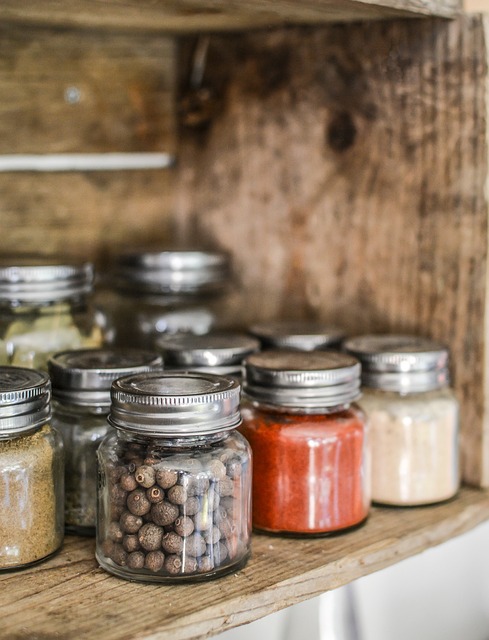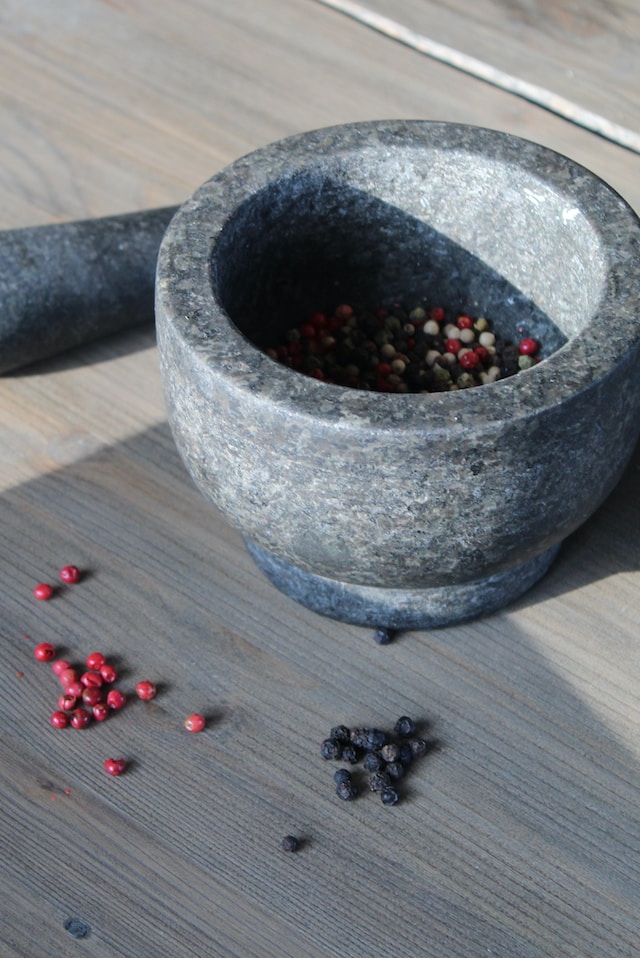
Spices, often derived from the seeds, roots, or barks of plants, have been cherished throughout human history for their ability to tantalize our taste buds and awaken our senses. These exotic treasures have travelled across vast distances, bridging cultures and adding depth to local cuisines with their magical touch.
Though the subject of spices may seem daunting and complex, we will approach it with a sense of ease and accessibility, ensuring that any aspiring chef, regardless of their culinary expertise, can confidently embark on this flavor-filled journey. Together, we will unlock a world of flavors, creating mouthwatering dishes that will leave a lasting impression on all who have the pleasure of experiencing them.
The Spice Pantry Essentials
Step into the heart of any kitchen, and you will find a treasure trove of carefully curated spices. These culinary gems, carefully selected and arranged, hold the power to transform even the simplest of meals into a symphony of flavors. In this section, we will explore the essential spices that every chef, amateur or expert, should have in their pantry. So let us begin our voyage into this fragrant world, unlocking the secrets of spices one by one.
- Cinnamon: Like a warm embrace in a cold winter’s night, cinnamon is a spice that brings comfort and warmth to any dish. Its sweet yet slightly pungent flavor infuses your baked goods with a touch of magic, while its earthy aroma transforms your morning coffee into a journey of the senses.
- Cumin: Venture into the depths of Middle Eastern and South Asian cuisines, and you will find cumin standing proudly as a culinary cornerstone. Its warm, nutty flavor adds depth and complexity to curries, stews, and roasted meats, making it a versatile spice that every chef should have at their fingertips.
- Paprika: Add a touch of vibrant color and smoky richness to your dishes with paprika. Derived from dried and ground chili peppers, this spice lends its distinctive flavor profile to Spanish and Hungarian cuisine. From paellas to goulashes, paprika takes center stage, transforming ordinary meals into culinary masterpieces.
- Turmeric: Known as the golden spice, turmeric boasts not only its vibrant hue but also its numerous health benefits. Its earthy flavor, with subtle notes of ginger and orange, adds a delightful twist to vegetable stir-fries, rice dishes, and soups. Explore the wonders of turmeric, and let its colorful magic brighten up your kitchen.
- Ginger: A spice revered for its versatility and medicinal properties, ginger packs a powerful punch in both flavor and aroma. Its spicy yet refreshing taste enlivens everything from stir-fries to desserts, while its zesty fragrance uplifts the spirits. Keep a fresh ginger root in your pantry, and unlock a world of culinary possibilities.
- Nutmeg: As you enter the realm of baking, nutmeg becomes your trusted ally, infusing your creations with its warm and slightly sweet essence. Sprinkle a pinch of this aromatic spice in your pies, custards, and even savory dishes, and witness how it elevates simple ingredients to extraordinary heights.
Remember, your spice pantry should be an ever-evolving collection, tailored to your taste preferences and culinary adventures. As you gain confidence and explore new flavors, allow your spice collection to expand and embrace the diversity that these spices offer.
Understanding Flavor Profiles
In the culinary world, understanding flavor profiles is like unraveling the intricate threads of a tapestry. It is the knowledge that guides us in creating harmonious and balanced dishes that dance on our palates. Each spice, with its unique characteristics, contributes to the overall flavor profile of a dish, and by mastering this art, you can take your cooking to new heights.

Sweet and Spicy: Sweet and spicy flavors play a delicate dance, creating a tantalizing balance that is both satisfying and exhilarating. Think of dishes like honey-glazed chicken with a hint of cayenne pepper or a mango salsa that combines the sweetness of the fruit with the heat of jalapenos. The contrast between the two creates a symphony of flavors that keeps our taste buds guessing.
Earthy and Savory: Earthy and savory flavors transport us to the heart of autumn, where the earth is rich with warmth and the air is heavy with the scent of fallen leaves. Spices like rosemary, thyme, and sage bring a sense of depth and groundedness to dishes like roasted vegetables or braised meats. These flavors provide a comforting and soul-nourishing experience that reminds us of the simple pleasures of the earth.
Tangy and Citrusy: Tangy and citrusy flavors are like a burst of sunshine on a cloudy day. They awaken our senses, invigorating our taste buds with their bright and zesty personality. Spices like lemon zest, lime juice, and vinegar add a refreshing twist to marinades, dressings, and even desserts. Their acidic nature brings balance and complexity to dishes, leaving a memorable impression.
Smoky and Bold: Smoky and bold flavors are what dreams are made of, transporting us to crackling bonfires and starlit skies. Spices like smoked paprika, chipotle, and mesquite lend their unmistakable smokiness to dishes like barbecued ribs or charred vegetables. The depth and richness of these flavors leave a lasting impact and create a sense of culinary adventure.
Fresh and Herbal: Fresh and herbal flavors bring a burst of green goodness to our plates, evoking images of blooming gardens and dew-kissed leaves. Spices like basil, mint, and cilantro add a vibrant layer of freshness to salads, sauces, and herb-infused oils. The bright, lively notes of these spices awaken our senses and elevate the simplest of dishes.
Understanding flavor profiles is not only about combining different flavors but also about listening to our instincts and finding our own unique blend. Experimenting with spices and exploring the endless possibilities they offer is an art form in itself. It is a journey of self-discovery, where each flavor profile becomes a brushstroke on the canvas of our culinary creations.
Enhancing Savory Dishes with Spices
When it comes to creating savory masterpieces in the kitchen, spices are your secret weapon. These aromatic gems have the power to transform ordinary ingredients into extraordinary culinary creations. From simple weeknight dinners to extravagant feasts, spices hold the key to unlocking a world of flavor that will leave your taste buds craving more.
- Garlic: Whether minced, crushed, or roasted, garlic brings a deliciously savory element to soups, sauces, rubs, and marinades. Don’t be afraid to experiment with different forms of garlic to achieve the desired intensity in your dishes.
- Rosemary: Its woody and slightly pine-like taste pairs perfectly with roasted meats, potatoes, and vegetables. Sprinkle some rosemary on your roasted chicken or toss it with olive oil and drizzle it over roasted root vegetables for a delightful burst of flavor.
- Thyme: Its subtle minty and citrusy undertones make it a versatile spice, perfect for seasoning soups, stews, pasta sauces, and roasted meats. The next time you’re sautéing vegetables or simmering a pot of soup, give thyme a try and experience the magic it brings to your creations.
- Oregano: Known as the “pizza herb,” oregano adds a vibrant and zesty flavor to savory dishes. Whether dried or fresh, this herb offers a robust and slightly bitter taste that complements tomato-based sauces, grilled vegetables, and Mediterranean-inspired dishes. Sprinkle some oregano on your homemade pizza or mix it into your pasta sauce for an extra burst of flavor.
- Chili Powder: Made from ground dried chili peppers, this spice adds a fiery kick to chili, tacos, salsas, and marinades. Be cautious when using chili powder, as its intensity can vary depending on the brand and blend. Start with a small amount and gradually increase to find your desired level of heat.
- Smoked Salt: Made by slowly smoking salt crystals over wood chips, this spice imparts a subtle smokiness that enhances grilled meats, roasted vegetables, and even popcorn. Sprinkle some smoked salt on your favorite dishes and let the smoky flavor tantalize your taste buds.
When using spices to enhance savory dishes, it’s essential to balance flavors and experiment with different combinations. The key is to start with small amounts, gradually adding more if needed, and tasting as you go.

Spices in Baking and Desserts
The world of spices is not limited to savory dishes alone. These flavorful gems have the power to transform your baked goods and desserts into delightful creations that will warm your heart and tantalize your taste buds. From aromatic cinnamon to exotic cardamom, let us embark on a sweet journey through the realm of baking with spices.
Cinnamon:
Ah, the sweet and comforting aroma of cinnamon. This beloved spice adds a touch of warmth to any sweet treat. From cinnamon rolls to apple pies, its delicate yet robust flavor elevates every bite. Sprinkle a dash of cinnamon over your morning oatmeal or mix it into your favorite cake batter for a cozy and nostalgic experience.
Nutmeg:
With its slightly sweet and nutty taste, nutmeg is a versatile spice that can elevate both sweet and savory dishes. In baking, it is often used alongside cinnamon to add depth and complexity. Add a pinch of nutmeg to your banana bread or sprinkle it over a creamy custard for a hint of warmth and richness.
Ginger:
The zesty warmth of ginger brings a unique flair to desserts. Whether used ground, fresh, or crystallized, ginger adds a delightful kick to cookies, cakes, and even ice cream. Try incorporating some ginger into your next batch of gingerbread cookies or infuse it into a creamy ginger crème brûlée for a truly indulgent treat.
Cardamom:
Exotic and fragrant, cardamom is a spice that adds a touch of sophistication to desserts. Its floral and citrusy notes pair beautifully with fruits, chocolates, and creamy delicacies. Sprinkle some ground cardamom into your next batch of sugar cookies or infuse it into a velvety vanilla ice cream for a taste that will transport you to far-off lands.
Vanilla:
While technically not a spice, vanilla deserves an honorary mention for its ability to enhance the flavors in baked goods. Whether using vanilla extract, beans, or paste, this aromatic ingredient adds a delicate sweetness to cakes, cookies, and pastries. Indulge your senses by scraping the seeds from a vanilla bean into your next batch of homemade custard or infusing the warm scent of vanilla into a creamy cheesecake.
The art of baking with spices is a dance of flavors, where the balance between sweetness and spice is key. Experimenting with different combinations and trusting your taste buds will lead you to create desserts that are truly unique and unforgettable.
Balancing Heat and Flavor
Achieving the perfect balance of heat and flavor in a dish is an art in itself. It requires an understanding of how different spices interact with our taste buds and knowing how to control their intensity. Whether you prefer a mild hint of warmth or crave a fiery explosion of flavor, mastering the art of balancing heat and flavor will take your culinary creations to new heights. Here are a few tips to help you strike that harmonious balance:
1. Start with small amounts: When working with hot spices like chili powder or cayenne pepper, it’s best to start with a small amount and gradually add more if desired. Remember, you can always add more spice, but it’s challenging to dial back the heat once it’s too overpowering.
2. Pair heat with sweetness: Sweetness can help temper the heat of spicy spices. Combining ingredients like honey, maple syrup, or brown sugar with hot spices creates a beautiful balance of flavors. The sweetness provides a pleasant contrast and softens the intensity of the heat.
3. Use cooling elements: Dairy products such as yogurt, sour cream, or coconut milk can help alleviate the heat in a dish. The creamy, soothing texture and cooling effect they provide can help balance the spiciness and create a more well-rounded flavor profile.

4. Citrus to the rescue: The bright, tangy flavors of citrus fruits like lemon, lime, or orange can counterbalance the heat of spices. Squeezing a bit of citrus juice over a spicy dish adds a refreshing zest that complements and tames the heat.
5. Balance with herbs and aromatics: Introducing fresh herbs and aromatics, such as cilantro, mint, or ginger, can bring an element of freshness to a spicy dish. These ingredients not only add complexity to the flavor but also help balance out the heat.
6. Let the heat shine: If you’re a heat lover, embrace the intensity of the spices and let them take center stage. However, it’s still crucial to add layers of flavor to keep the dish interesting. Experiment with different combinations of spices and seasonings to find the perfect balance that suits your palate.
Remember, everyone’s tolerance for spicy flavors differs, so feel free to adjust the heat level according to your preferences. The key is to create a dish that delights your taste buds and leaves you satisfied without overwhelming your senses. Balancing heat and flavor is a skill that develops over time, so don’t be afraid to experiment and trust your instincts. With practice, you’ll become a master of creating dishes that are both spicy and full of depth.
